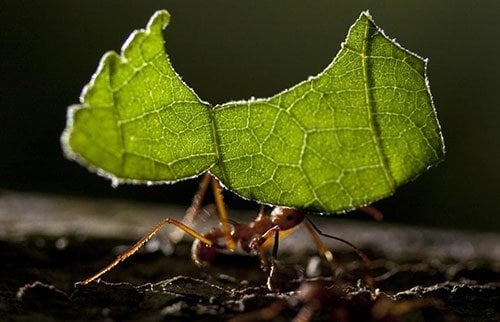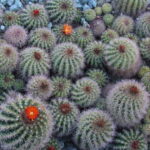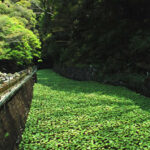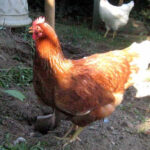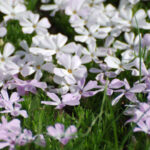When you step into your yard to relax in the evening, the last thing you want to see is a line of ants plodding along what appears to be a spontaneous ant highway. Unfortunately, our yards, gardens, and even our homes attract ants like a local park draws children — and they want to stay. Unfortunately for us, any period of time they’re around is generally too long!
While most ants don’t typically carry illnesses, they are a nuisance. They tend to live in large colonies, and an ant leaves scent trails that can indicate where its friends can follow to go acquire food or water to take home. In this guide, we’ll look at a number of ways to avoid, control, or kill ants, even if they’ve already moved in and gotten comfortable.
Listen to this post on the Epic Gardening Podcast
Subscribe to the Epic Gardening Podcast on iTunes
Common Ant Species
Some ant species reside in colonies which are based on just one queen, while others are based on multiple queens. There are over 12,000 known types of ants worldwide. Here’s a few common varieties and some information about them.
Argentine Ant (Linepithema humile)

Quick Facts
- Argentine ants are common in the southeastern USA and California.
- These ants seldom get larger than ⅛”, and can be even smaller. Worker ants, which are the most often seen, are light to medium brown in color and are shiny. The only winged Argentine ants are the queens and they’re rarely seen.
- Argentine ants and fire ants are rarely in the same area as they fight for food sources. If you have one variety, you probably don’t have the other.
- They form megacolonies, and can have multiple queens in one immense nest. They can quickly invade an entire yard or even neighborhood when groups splinter off to form other nests. They can quickly relocate their entire nest to move closer to a food source.
- They nest in moist soil under logs, mulch, debris, or concrete slabs,, and can often be seen on sidewalks or plants. In the winter, they often try to move indoors.
- Eats sweets, fats, and oils.
Black House Ant (Monomorium minimum)
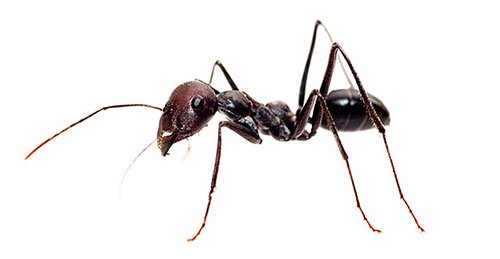
Quick Facts
- Sometimes called “little black ants”.
- While they are throughout the United States, they are most common in the east.
- They build outdoor colonies under logs, rocks, debris, and in landscape mulch. They are also one of the most common ants found indoors, and indoors they will nest in walls, under carpets, in woodwork or decaying wood, and in masonry.
- If indoors, they often travel along baseboards or carpet edges.
- They prefer sweets, fats and oils as food sources.
Rover Ant (Brachymyrmex spp)
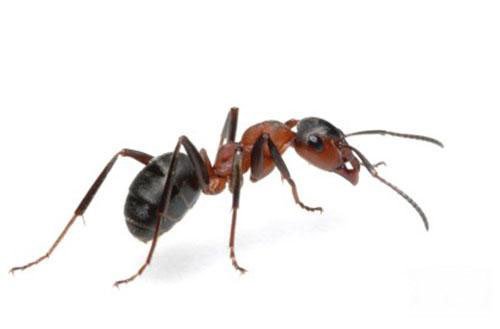
Quick Facts
- These are sometimes called “seaside rover ants”. They are common in the Gulf states and in parts of Texas, Arizona, Nevada, and southern California.
- These ants are small, no bigger than a twelfth to a sixteenth of an inch in size.
- Rover ants fly to mate, and in some environments they mate year-round. The worker ants are not winged.
- Outdoors, they nest under mulch, heavy vegetation, rotting wood, or in potted plants. They enter homes via cracks in walls, openings around pipes, and windows, and can climb trees for access to the home. Indoors, they tend to favor moist environments and are often found in bathrooms and kitchens.
- This is a relatively new pest species for most of the western US, but has been established in the Gulf region for many decades.
- Eats sweets.
Fire Ant (Solenopsis spp)

Quick Facts
- There are many species of fire ants, and some have a painful stinging bite.
- They nest outdoors in large mounds and can be quite aggressive.
- Fire ant colonies can grow to be hundreds of thousands of ants in size.
- This type of ant is common throughout the southern United States.
- Fire ants will eat almost any kind of plant or animal matter, but prefer high-protein food.
Black Garden Ant (Lasius niger)

Quick Facts
- Black garden ants can be found throughout the United States.
- Workers average 3-5mm in length. Males are 3.5-4.5mm long, and queens can reach 6-9mm.
- Garden ants fly to mate. Once fertilized, queens will remove their wings and digest their wing muscles as food during the winter.
- Most colonies are 4,000-7,000 ants, but can reach sizes of up to 40,000 ants.
- Black garden ants nest underground, commonly under stones or in rotten wood.
- Likes nectar, fruits, small insects.
- These ants will farm aphids for honeydew as an additional food source.
Carpenter Ant (Camponotus spp)
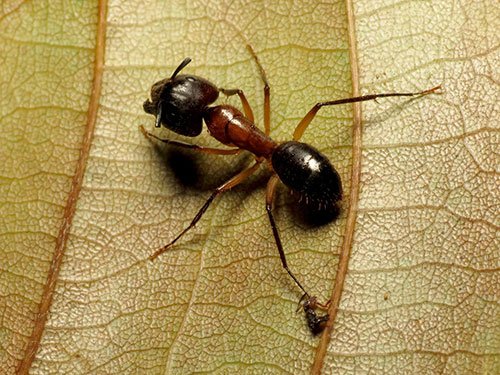
Quick Facts
- Carpenter ants come in many colors and many sizes. They are found throughout the United States.
- They hollow out dead, moist wood in trees, fence posts, and firewood to build nests. However, they don’t eat wood. Inside, they build colonies in wall voids, foam insulation, eaves, and crawlspaces.
- Carpenter ants forage at night during the summer.
- They feed on insects and insect secretions during the summer. In the spring and fall, they often invade homes to find other food sources.
- Likes sweets.
Leaf Cutter Ant (Acromyrmex and Atta spp)
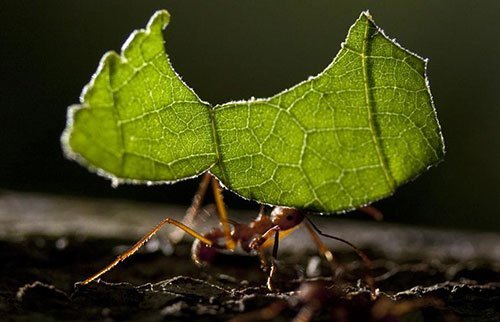
Quick Facts
- Leaf cutters are also known as “cut ants” or “parasol ants”. There are many varieties over two different species.
- They are common in eastern and south central Texas and parts of western Louisiana.
- These are considered an agricultural pest, and have become a major problem in Central and South America.
- Leaf cutters fly en masse to mate. A queen mates with multiple males.
- These ants can carry more than 20 times their body weight, and are easily identifiable in the wild as the workers are carrying large chunks of foliage.
- Leaf cutters got their name by removing foliage from plants to take home to the nest. There, they chew the foliage into a pulp and use it to farm a specific fungus to help feed the colony.
Ant Invasion Signs
For most people, the first sign of ant invasion in the garden is that marching ribbon of hundreds of them. But are there other signs to be wary of?
- Singular “rogue” ants. Some varieties of ant send out scouts to search for food or water sources. If you see any lone ants wandering on plant leaves or inside your house, they aren’t just out for a stroll. They’re actively searching for food or water.
- Ant highways/trails. We’ve all been on a busy road, and ants have something similar. They create pheromone trails which can lead to meal or water sources, and it’s like building a paved road – where one ant goes, others can assuredly follow, and they often do. Even if you only see a few of them, but they seem to be following the same route, that could be an ant trail.
- Ant nest entrances. A nest site can look like a small hole with dirt mounded up around the edges, or can become an actual raised anthill, depending on how long it has been there. They can be quite cunning in the placement of their nests – you can often find evidence of ants in pavement cracks or between paving bricks. If there is a regular source of food, they will try to live fairly nearby, so compost piles or trashcans are not immune. In the heat of midsummer, their nests might be harder to spot.
- Hundreds of aphids located on a single plant. If you see a lot of aphids on a specific plant, and then notice an ant or two nearby, that’s a warning sign in your garden. Some species of ant will actually farm aphids for their honeydew, a secretion that the aphids produce that the ants will eat. The ants will pick up aphids that they find, carry them to your plant, and set up a large colony.
- Wandering pieces of leaves. While this sounds strange, the ridiculously-strong leaf cutter ants can carry up to 20 times their own weight, which means that if you happen to see a line of moving chunks of leaves, you may have a colony of leaf cutters nearby.
Wait, Ants Are Farmers?
As a matter of fact… yes. Leaf cutter ants have fungi gardens, and a few other varieties of ants herd and care for aphids. This is a beneficial relationship between the ants and their crop or herd of choice. You can learn more about it by watching this short video.
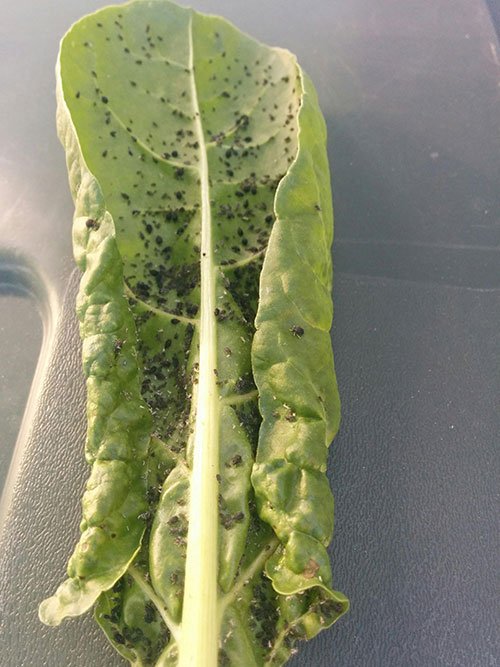
13 Ways To Eliminate Ants
If you have ant issues, there’s a wide selection of options for you to choose from, both chemical and organic. These are some of the options to combat ants in your home and garden… and if all of these fail, you can always contact your local pest control agency for professional assistance, too.
Use homemade sweet ant bait. You can make a homemade ant bait using borax. A mixture of a half teaspoon of borax, a half teaspoon of a sugar substitute, and a half teaspoon of honey will make a sticky, but still somewhat granular paste bait – you can spoon that into old open jars or bottle caps and place it around the nest or in the middle of an ant trail.
Make peanut-butter poison. Mix a heaping tablespoon of creamy peanut butter with a level tablespoon of sugar and a teaspoon of borax, being sure to blend all of the ingredients thoroughly. Then, take small ½” to 1” long pieces of plastic straws and fill them with the peanut butter and place them as you would other ant baits. This will poison the ants who prefer oils, fats, and proteins.
Spread beneficial nematodes. The variety of beneficial nematodes which is most effective against ants is Steinernema carpocapsae, a variety which attacks a wide variety of mobile insects including ants, fleas, caterpillars, and more. If you spread beneficial nematodes directly onto and into the nest and around your garden and yard, you may notice a reduction in ant populations over time. However, since nematodes only have a lifespan of a couple of weeks once they’re brought ouf of the hibernation state they’re normally shipped in, you may have to apply them once a week for 2-3 weeks to guarantee that there are enough in various stages of their lifecycle to maintain them in the soil. In addition, this variety of beneficial nematode is not very mobile, so you will want to ensure that you put them directly where you want them by using a hose-end sprayer to apply them where you wish them to be. Nematodes do not work on fire ants effectively.
Use neem oil on plants to eliminate aphid farms. If you do find aphid farms on your plants, apply neem oil to eliminate the aphids that the ants are farming. If you kill their food source, ants will be less likely to frequent that area, but it won’t eliminate the ants entirely. This is best used in conjunction with other ant elimination methods.
Fight them with citrus oils. Orange and lemon oils are toxic to ants, which is why you don’t often see ants near citrus trees. You can make a spray for your plants from ¾ cup of orange essential oil, 1 tablespoon of dish soap, 1 tablespoon of molasses, and a gallon of water. Spray this on and around your plants, making sure to dampen the soil’s surface as well.
Battle them with citrus peels. Don’t have essential oil in the house? Use orange peels instead. Place five or six good-sized orange peels into some water in a pot on the stove, and boil them until they’re soft (about 15 minutes). Once they’re soft, you can add the liquid and peels into a food processor and make an orange slurry that you can pour around your plants.
Clean them from the inside out. Dish soap is an inexpensive home insecticide. Put a teaspoon of dish soap into about a pint of warm water and stir it up good, and then spray that on and around your plants. If you need to, you can make this a little bit soapier, but be careful as some of your plants might not appreciate too much soap. You can also mix dish soap with hot water and pour it into the openings of ant nests to kill the ants inside. As long as it’s not going to be sprayed directly onto your plants, be generous with the soap!
Dry-drown them. Ants don’t like many mineral powders as the sharper edges cut them up and dehydrate them – but we can’t even feel the sharp edges. This means that you can use baby powder or food-grade diatomaceous earth in a powder-sprayer on the ant nest or anthill. Start by following any visible outdoor trails and dusting the trails with the powder. Once you reach the anthill or nest, dust more evenly over the exterior. Then put the nozzle of the powder-sprayer into the entrance and coat as much of the interior of the nest as you can with the powder. If you have a particularly deep nest, this may not be effective as they may just create another exit, but for shallow nests it works well.
Use peppermint prevention indoors. Ants do not like peppermint. You can create an invisible, minty-fresh barrier by placing peppermint essential oil inside your house near potential entry points for ants. Swipe some on with a cotton ball, or mix some with water and spray it around inside. You can even soak a cotton ball in the oil and leave it near a regularly-frequented area to discourge scouts. Essential oils don’t last for long, so you may need to replace it regularly, but it smells wonderful!
Stop indoor ant trails with vinegar. Make a solution of equal parts of vinegar and water, and put it in a spray bottle. Use this spray along any ant trails you might find in your house, and wipe it off. The vinegar will mask the pheromones from the ant trail. You can also use vinegar to spray baseboards, cracks, and any other places that ants might enter the home as a deterrent.
Eliminate food and water sources. While this seems obvious, it’s always important to remember that ants usually try to come inside for food or water. Whenever possible, make sure that any enticements are eliminated to keep them out of the home.
For those of you that want to use a non-natural method, here are two for you:
Use commercial ant bait. There are commercial ant baits available which the ants will take back to their nests, thinking it’s food. They share it with the others, and then the ants will slowly die. This process takes some time to have a full effect, and requires you to be vigilant – anywhere you see ant trails or nest entrances, broadcast the bait around those areas to encourage ants to take it home.
Use a commercial pesticide spray. There are tons of pesticide sprays out there, all using different chemicals. For ants that live in walls and pavement, you should use a spray containing bifenthrin. Spray the nest directly and then spot-treat in areas where you still see ants. If you can’t find a bifenthrin spray, carbaryl or pyrethroid sprays may also work.
With over 12,000 species of ants in the world, it might seem a daunting task to combat these pests, but I hope that I’ve given you a great place to start!

